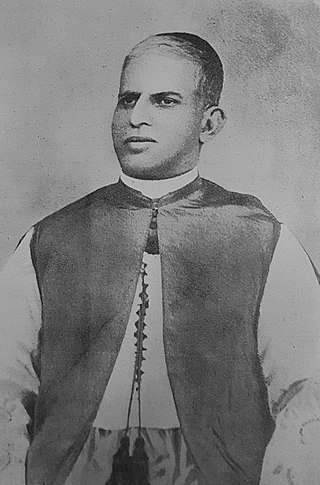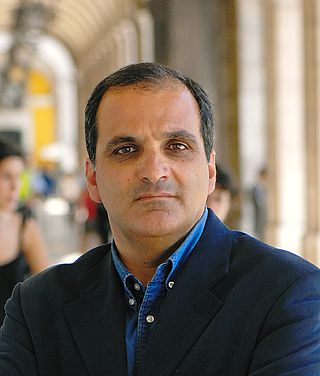Related Research Articles

Conspiracy of the Pintos, also known as the Pinto Revolt or the Pinto Conspiracy, and in Portuguese as A Conjuração dos Pintos, was a rebellion against Portuguese rule in Goa in 1787. The leaders of the plot were three prominent priests from the village of Candolim in the concelho of Bardez, Goa. They belonged to the Pinto clan, hence the name of the rebellion.
Candolim is a census town in North Goa and is located in the Bardez taluka in the state of Goa, India. It is situated just south of Calangute Beach and North of Sinquerim.
Thomas Stephens was an English Jesuit priest and missionary in Portuguese India, writer and linguist.

The Roman Catholic Metropolitan Archdiocese of Goa and Daman encompasses the Goa state and the Damaon territory in the Konkan region, by the west coast of India. The ecclesiastical province of Goa and Damaon includes a suffragan diocese, the Sindhudurg Diocese that comprises the Malvani areas of. The Archbishop of Goa also holds the titles of Primate of the East and Patriarch of the East Indies, also hold the title of the Syrian Catholic Primate of the Archdiocese of Cranganore. The beginnings lie in the Padroado system of Portuguese Goa and Damaon, in the early 1900s the primatial see was transferred back to the Sacred Congregation for the Evangelisation of Peoples, as the Padroado system of the Indo-Portuguese era was being dismantled.

Msgr Sebastião Rodolfo Dalgado was a Catholic priest, academic, university professor, theologian, orientalist, and linguist from Portuguese Goa.
Several poems, known popularly as Paixao de Cristo in Portuguese, and as Christi Vilapika in Marathi, were written in Goa during the 17th century in the Marathi language using the Latin script, based on the sublime pathos of the crucifixion of Jesus Christ. Some of these poems were well-known to scholars like A.K. Priolkar and V.B. Prabhudessai, who called for critical study of them. Critical texts of three of these have recently been published in the book Goan Christian Marathi Vilapika during the 17th Century by Dr. S. M. Tadkodkar, currently Head of the Department of Marathi at the Goa University.
The Konkani language agitations were a series of protests and demonstrations in India, concerning the uncertain future and the official status of the Konkani language. They were held by Goans in the then union territory of Goa, Daman and Diu under the Maharashtrawadi Gomantak Party. The protests involved citizen journalism, student activism and political demonstrations.

Fort Santíssima Trindade also known as Fort Tiracol, is a Portuguese era fort near the village of Tiracol, in the North Goa district of Goa, India. At the mouth of the Terekhol River, the fort can be reached by a ferry from Querim, 42 km (26 mi) north of Panaji.
José Gerson da Cunha was a Goan physician who achieved international renown as an indologist, historian, linguist and numismatist.

Luso-Indians or Portuguese-Indian, is a subgroup of the larger Eurasian multiracial ethnic creole people of Luso-Asians. Luso-Indians are people who have mixed Indian and Portuguese ancestry or people of Portuguese descent born or living or originating in former Portuguese Indian colonies, the most important of which were Goa and Damaon of the Konkan region in the present-day Republic of India, and their diaspora around the world, the Anglosphere, Lusosphere, the Portuguese East Indies such as Macao etc.
The Arte da Lingoa Canarim, the grammar of the Konkani language, was composed by the 16th-century English Jesuit priest Father Thomas Stephens, thus making Konkani the first among the modern Indian languages to have its grammar codified and described. The system was expanded upon by Diogo Ribeiro and four other Jesuits and printed in Rachol in the year 1640. A second edition was then developed and introduced in 1857 by J.H. da Cunha Rivara, who possessed a great passion for Konkani. Consequently, three versions of the Arte exist:
- Arte da lingoa Canari. MS held by the School of Oriental and African Studies, London.
- Arte da lingoa Canarim, composed by Padre Thomaz Estevão and Padre Diogo Ribeiro of the Company of Jesus & amended by other Padres of the same company. 1640.
Joaquim Heliodoro da Cunha Rivara was a Portuguese physician, professor, intellectual and politician. He excelled as a scholar of the history of the Portuguese presence in India and as a champion of the Konkani language.

Walter Rossa is architect, urban planner, researcher and Professor of University of Coimbra.
Rogério de Faria was a Luso-Goan businessman.

Francisco Newton João Vicente da Piedade Jaime Valfredo Rangel was a medical practitioner, director of Tipografia Rangel, president of the municipal council of Bardez in Goa and a delegate to the International Labour Organization for Portugal.

Filipe Nery Xavier, sometimes spelt Felipe, Felippe, Filippe or Neri, was a Portuguese administrator, littérateur and historian of Goan origin. He was descended from a "very distinguished" Gaud Saraswat Brahmin family that had converted to Christianity when the Portuguese arrived in India. Despite having no or very little European blood, the Xavier family flourished in the eighteenth and nineteenth centuries, holding positions such as interim Secretary General of Portuguese India, secretary to the Governor General of Mozambique, president of the municipal council of Mozambique and commander of the artillery of Lisbon's National Guard.

Fort Santo Estevão is a military structure erected in Santo Estevão Island, in Goa, by the Portuguese.
Jácome de Olivares was a Cochin Jew who converted to Catholicism in Portugal (converso). He later re-converted to Judaism after fleeing to the Ottoman Empire in 1571. Olivares was mostly active as a merchant, and spied for the Ottoman Sultan Selim II in Kochi, Portuguese India. He was part of Joseph Nasi's worldwide network of spies for the Ottoman Empire.
Leopoldo Cipriano da Gama Esq. was a Goan journalist and writer who was active during the era of Portuguese India. He was one of the notable contributors in the Portuguese weekly newspaper called "A Convicção". Through his articles, he skillfully conveyed his humanistic education, ensuring that the Portuguese content he presented to readers was thoughtfully organized and devoid of excessive, unprocessed facts.
References
- 1 2 3 "The Portuguese in Goan Folklore - GOACOM - GOA - INDIA - INFORMATION AND SERVICES IN GOA. Goa News, Goa Konkani News, Goa Sunaparant News, Goan Konakani News, Goa Video News, Goa Yellow Pages". Archived from the original on 2015-07-24. Retrieved 2015-07-24.
- ↑ "IGSG - Indo German Friendship Society, Goa".